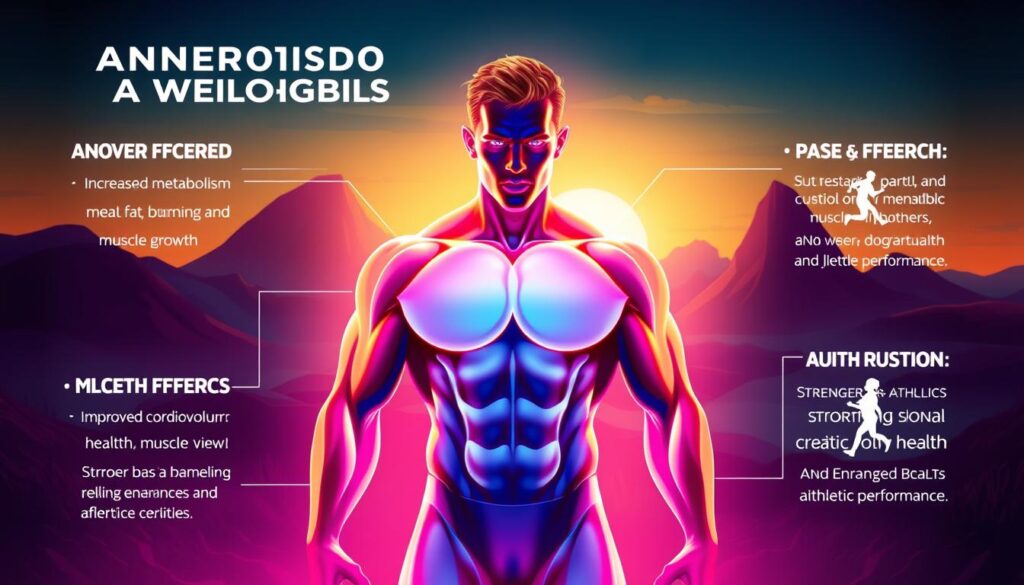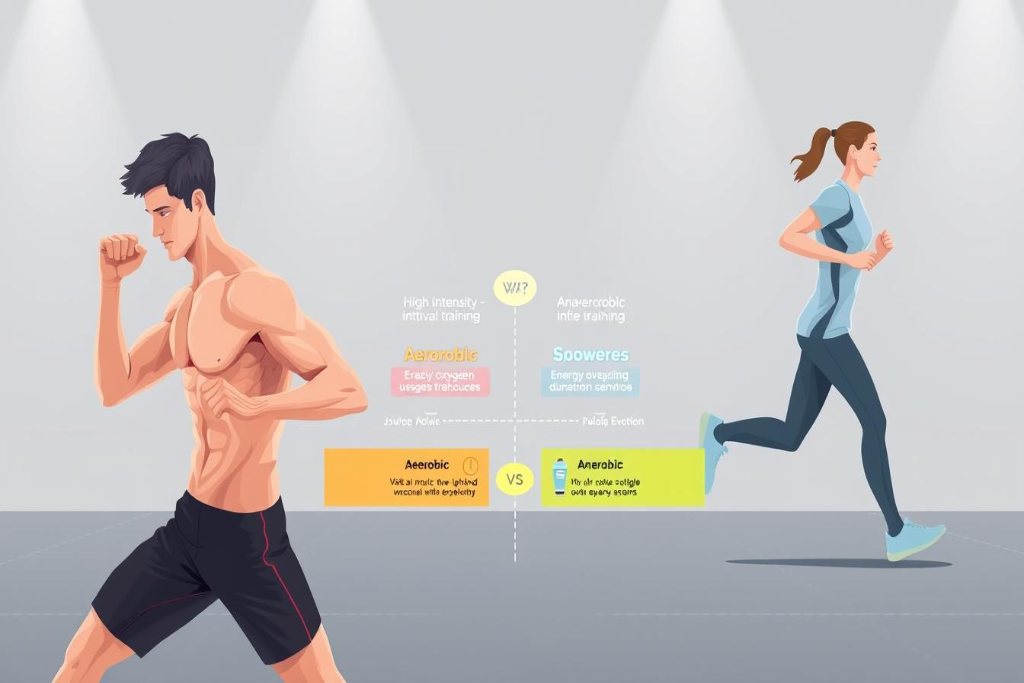Knowing your exercise types is key to reaching your fitness goals. There are two main types: aerobic and anaerobic exercises. Both are important for a complete fitness plan, but have different roles and benefits.

>>>> Click Here To Earn Your First $1,000 With AI Shorts
Aerobic exercises, like running or cycling, are long activities that boost heart health. Anaerobic exercises, such as weightlifting, are intense and build muscle and strength.
Key Takeaways
- Knowing the difference between aerobic and anaerobic exercises is vital for a balanced fitness routine.
- Aerobic exercises improve cardiovascular health and endurance.
- Anaerobic exercises build muscle and increase strength.
- Incorporating both types of exercises can enhance overall fitness.
- A well-rounded fitness routine includes a mix of aerobic and anaerobic activities.
Understanding the Basics of Energy Systems
When we exercise, our bodies use different ways to get energy. This complex process involves many systems working together, and it helps us get the energy we need for physical activity.
How Your Body Produces Energy During Exercise
The body makes energy through a process called cellular respiration. It breaks down nutrients to create ATP, the energy our cells use. There are three main energy systems: the phosphagen, glycolytic, and oxidative systems.
The phosphagen system gives us quick energy for short, intense activities. The glycolytic system helps for a bit longer, intense efforts. The oxidative system, which needs oxygen, is used for longer, less intense activities.
>>>> Click Here To Earn Your First $1,000 With AI Shorts
| Energy System | Primary Use | Duration |
| Phosphagen | Low-intensity, long-duration | 0-10 seconds |
| Glycolytic | High-intensity, moderate duration | 10 seconds to 2 minutes |
| Oxidative | Low-intensity, long duration | More than 2 minutes |
The Role of Oxygen in Exercise
Oxygen is key for energy production during exercise, especially in the oxidative system. Aerobic exercises, like long-distance running or cycling, need a lot of oxygen. On the other hand, anaerobic exercises, like sprinting or weightlifting, don’t need oxygen.
Knowing how oxygen works helps us understand the difference between aerobic and anaerobic exercises. This knowledge helps us create effective workout plans.
Understanding aerobic and anaerobic energy production is key to knowing how exercises benefit us. By knowing how oxygen and different energy systems work, we can design workouts that meet our fitness goals.
>>>> Click Here To Earn Your First $1,000 With AI Shorts
What Is Aerobic Exercise?
Aerobic exercise, also known as cardio, boosts heart health by raising heart rate and improving oxygen use. It helps the body use oxygen better, enhancing fitness and health. Regular aerobic workouts can greatly improve your overall well-being.
Definition and Physiological Mechanisms
Aerobic exercise needs oxygen to create energy. It makes the body use more oxygen, increasing heart and breathing rates. This boosts oxygen delivery to muscles, helping them turn glucose into energy.
The body’s energy production during aerobic exercise mainly uses aerobic glycolysis. This process breaks down glucose with oxygen to make ATP, the cell’s energy. It’s efficient and can last longer, perfect for endurance activities.
Intensity Levels and Heart Rate Zones
Aerobic exercise intensity varies, from walking to running or cycling. Knowing heart rate zones helps tailor workouts to fitness goals. Heart rate zones range from very light (Zone 1) to maximum effort (Zone 5).
Working out in specific heart rate zones targets different fitness improvements. For example, Zone 2 (aerobic endurance) boosts fat metabolism. Zone 4 (high-intensity aerobic) helps improve lactate threshold.
Common Examples of Aerobic Activities
Examples of aerobic exercises include brisk walking, jogging, cycling, swimming, and dancing. These activities can be done at various intensities and suit different fitness levels. Group fitness classes, like aerobics or spinning, offer a fun, social way to exercise.
>>>> Click Here To Earn Your First $1,000 With AI Shorts
Choosing enjoyable exercises that can be done regularly is key. This ensures long-term commitment to an aerobic routine.
Anaerobic Exercise: Definition and Fundamentals
Anaerobic exercise is about short, intense efforts. It’s a key part of staying fit. Unlike aerobic exercise, it uses stored energy, not oxygen.
It helps build strength and muscle. Fitness experts say it boosts fitness levels.
How Anaerobic Energy Systems Work
Anaerobic systems give quick energy for short, intense activities. Your body uses ATP and creatine phosphate for these efforts. This is why it’s great for quick power, like sprinting or lifting weights.
Sports scientists say this system lets you go all out for up to 30 seconds. Then, you need to rest.
>>> Get More Views On YouTube Fast
Intensity Requirements and Duration
Anaerobic workouts are intense and short. They last from seconds to a few minutes. The effort is so high, you can’t keep it up for long.
For example, sprinting 100 meters fast is anaerobic. So is lifting heavy weights, like squats and deadlifts, when you go all out.
Popular Types of Anaerobic Workouts
Some top anaerobic workouts include:
- High-Intensity Interval Training (HIIT)
- Sprinting
- Weightlifting
- Jump squats and other plyometric exercises
- Resistance band training
These workouts boost muscle strength and endurance. They also improve athletic performance. As
“Anaerobic training is a game-changer for those looking to push their fitness to the next level.”
Key Differences Between Anaerobic and Aerobic Exercise
It’s important to know the differences between anaerobic and aerobic exercise. They both help with fitness, but in different ways. They affect the body differently and have different benefits.
>>> Get More Views On YouTube Fast
Energy Production Pathways
Anaerobic exercise doesn’t need oxygen to work. It uses stored ATP and glycogen for quick, intense efforts. Aerobic exercise, however, needs oxygen to make energy. It uses fats and glucose for longer, less intense workouts.
Duration and Intensity Comparison
Anaerobic exercises are short and very intense, like sprinting or weightlifting. Aerobic exercises, like jogging or cycling, last longer and are less intense.
| Exercise Type | Duration | Intensity |
| Anaerobic | Short (seconds to minutes) | High |
| Aerobic | Long (minutes to hours) | Moderate |
Muscle Fiber Recruitment
Anaerobic exercises mainly use fast-twitch muscle fibers for strength and power. Aerobic exercises, on the other hand, use slow-twitch muscle fibers for endurance.

>>> Get More Views On YouTube Fast
aerobic vs anaerobic exercise
Recovery Requirements
Anaerobic exercises need longer to recover because of lactic acid and muscle damage. Aerobic exercises require less recovery time since they cause less muscle damage.
In conclusion, knowing the differences between anaerobic and aerobic exercise helps create a balanced workout plan. This meets individual needs and goals.
Benefits of Aerobic Exercise
Regular aerobic exercise greatly improves both physical and mental health. Adding aerobic activities to your routine boosts fitness and well-being.
Cardiovascular Health Improvements
Aerobic exercise strengthens the heart and boosts blood flow. This can lower blood pressure and reduce heart disease risk. Regular aerobic activity also improves heart function, making daily tasks easier as you age.
Weight Management and Fat Loss
Aerobic exercise helps manage weight and burn fat. It increases metabolism and calorie burn. Pairing it with a healthy diet enhances these benefits, helping you reach and keep your weight goals.
Mental Health and Cognitive Benefits
Aerobic exercise positively affects mental health, reducing anxiety and depression. It also boosts memory and concentration. The endorphins released during exercise improve mood and well-being.
Endurance and Stamina Development
Regular aerobic exercise boosts endurance and stamina. It makes daily tasks and physical activities easier. This is great for sports enthusiasts or those with demanding physical jobs. A table summarizing the benefits of aerobic exercise is provided below:
>>> Get More Views On YouTube Fast
| Benefit | Description | Impact |
| Cardiovascular Health | Improves heart health and circulation | Reduces risk of heart disease |
| Weight Management | Aids in weight loss and fat reduction | Improves body composition |
| Mental Health | Reduces symptoms of anxiety and depression | Enhances mood and cognitive function |
| Endurance and Stamina | Improves physical performance and daily functioning | Enhances overall quality of life |
Benefits of Anaerobic Exercise
Anaerobic exercise does more than build muscle. It also boosts metabolic health and overall well-being. High-intensity, short-duration activities offer many benefits. These can improve athletic performance and health markers.
Muscle Building and Strength Gains
Anaerobic exercise is great for building muscle and increasing strength. Through resistance training and HIIT, you can get stronger. This makes daily tasks easier and lowers injury risk.
Metabolic Effects and EPOC
Anaerobic exercise has a big effect on metabolism, especially EPOC. EPOC means your body uses more oxygen after intense workouts. This raises your metabolic rate, helping with weight control and improving health.

Benefits of anaerobic exercise
Bone Density and Joint Health
Weight-bearing exercises like resistance training boost bone density. This lowers the risk of osteoporosis and fractures. Strengthening muscles around joints also improves joint stability and reduces injury risk.
Performance Enhancement
Anaerobic exercise improves strength, power, and endurance. This is great for sports and activities needing quick energy or sustained strength.
>>> Get More Views On YouTube Fast
| Benefit | Description | Impact |
| Muscle Building | Increased muscle mass through resistance training | Enhanced physical appearance and functional strength |
| Metabolic Effects | EPOC leading to increased caloric burn | Aids in weight management and improves metabolic health |
| Bone Density | Improved bone density through weight-bearing exercise | Reduces risk of osteoporosis and fractures |
| Performance Enhancement | Improved muscular strength, power, and endurance | Enhances athletic performance and reduces injury risk |
How to Create a Balanced Fitness Routine with Both Exercise Types
Creating a fitness plan with both types of exercise can boost your fitness journey. A balanced routine is key for overall health and fitness.
Step 1: Assess Your Current Fitness Level
First, assess your current fitness level. Look at your heart health, muscle strength, flexibility, and body shape. You can get help from a fitness expert or use tools to check your fitness level.
Step 2: Determine Your Fitness Goals
Next, set clear fitness goals. Do you want to lose weight, build muscle, or get healthier? Your goals will help decide how much anaerobic and aerobic exercise you need. For example, more anaerobic for muscle, more aerobic for weight loss.
Step 3: Design Your Weekly Workout Schedule
Now, plan your weekly workouts. Mix anaerobic and aerobic exercises. Aim for 2-3 days of each. Include rest days for recovery.
>>> Get More Views On YouTube Fast
| Day | Workout Type | Activity |
| Monday | Anaerobic | Weightlifting |
| Tuesday | Aerobic | Jogging |
| Wednesday | Rest | – |
| Thursday | Anaerobic | HIIT |
| Friday | Aerobic | Cycling |
Step 4: Implement Progressive Overload
To keep improving, add progressive overload to your workouts. Gradually increase the challenge of your exercises. For anaerobic, lift heavier or do more reps. For aerobic, go longer or harder.
Sample Workout Plans for Different Fitness Goals
Creating a good workout plan means knowing how to mix anaerobic and aerobic exercises. It’s important to match your plan to your fitness goals. Whether you want to lose weight, build muscle, or get fit overall, the right plan can help.
For Weight Loss: Combining HIIT and Steady-State Cardio
For losing weight, mixing High-Intensity Interval Training (HIIT) with steady-state cardio works well. HIIT has short, intense workouts followed by rest. Steady-state cardio keeps you moving at a steady pace for longer. Together, they boost your metabolism and burn calories.
For Muscle Building: Strength Training with Cardio Support
Building muscle needs strength training, which is anaerobic. This means using weights to build muscle. Adding some cardio helps by improving heart health and aiding in recovery.
For Overall Fitness: Balanced Approach to Both Systems
For overall fitness, balance is key. Mix anaerobic and aerobic exercises. You can alternate days or blend them in one workout. This improves heart health, boosts strength, and increases flexibility.
In conclusion, a good workout plan depends on knowing your goals. By mixing anaerobic and aerobic exercises, you can create a balanced and effective fitness routine.
>>> Get More Views On YouTube Fast
Conclusion: Finding Your Optimal Exercise Balance
Knowing the difference between anaerobic and aerobic exercise is key. It helps you create a good fitness plan. You can focus on improving heart health, building muscle, or boosting fitness overall.
Getting the right mix of exercises is important. You need both aerobic activities like jogging and anaerobic ones, like weightlifting. This balance helps you stay healthy, perform better, and avoid injuries.
When planning your workouts, think about your goals and what you like. Finding the right balance between aerobic and anaerobic exercises is crucial. It helps you make steady progress and enjoy fitness for the long haul. Whether you’re new to fitness or have been doing it for years, knowing the difference is vital.
FAQ
What’s the main difference between aerobic and anaerobic exercise?
Aerobic exercise uses oxygen to make energy. Anaerobic exercise doesn’t use oxygen. It relies on stored energy instead.
How does the intensity of aerobic vs. anaerobic exercise compare?
Anaerobic exercise is very intense but short. Aerobic exercise is less intense but goes on longer.
Can you provide examples of anaerobic and aerobic exercises?
Anaerobic exercises are things like weightlifting, sprinting, and HIIT. Aerobic exercises include jogging, cycling, and swimming.
Which is better: aerobic or anaerobic exercise?
Both are good for different reasons. A mix of both is best for a well-rounded fitness routine.
How does anaerobic exercise differ from aerobic in terms of energy production?
Anaerobic exercise uses muscle energy. Aerobic exercise uses oxygen to turn fat and glucose into energy.
When should I do aerobic vs. anaerobic training?
Do aerobic training for heart health and endurance. Anaerobic training is better for building strength and muscle.
What are the benefits of incorporating both aerobic and anaerobic exercise into my fitness routine?
Mixing both exercises boosts fitness, burns more calories, and improves sports performance.
How can I create a workout plan that includes both aerobic and anaerobic exercises?
First, know your fitness goals and level. Then, plan a mix of both exercises. You can alternate days or use HIIT.
Are there any specific workout plans that can help me achieve my fitness goals using a combination of aerobic and anaerobic exercises?
>>> Get More Views On YouTube Fast
Yes. For losing weight, try HIIT with steady cardio. For building muscle, do strength training with cardio support.
How often should I do aerobic vs. anaerobic exercise to see results?
How often depends on your goals. Aim for 150 minutes of aerobic exercise and 2-3 strength training sessions weekly.




